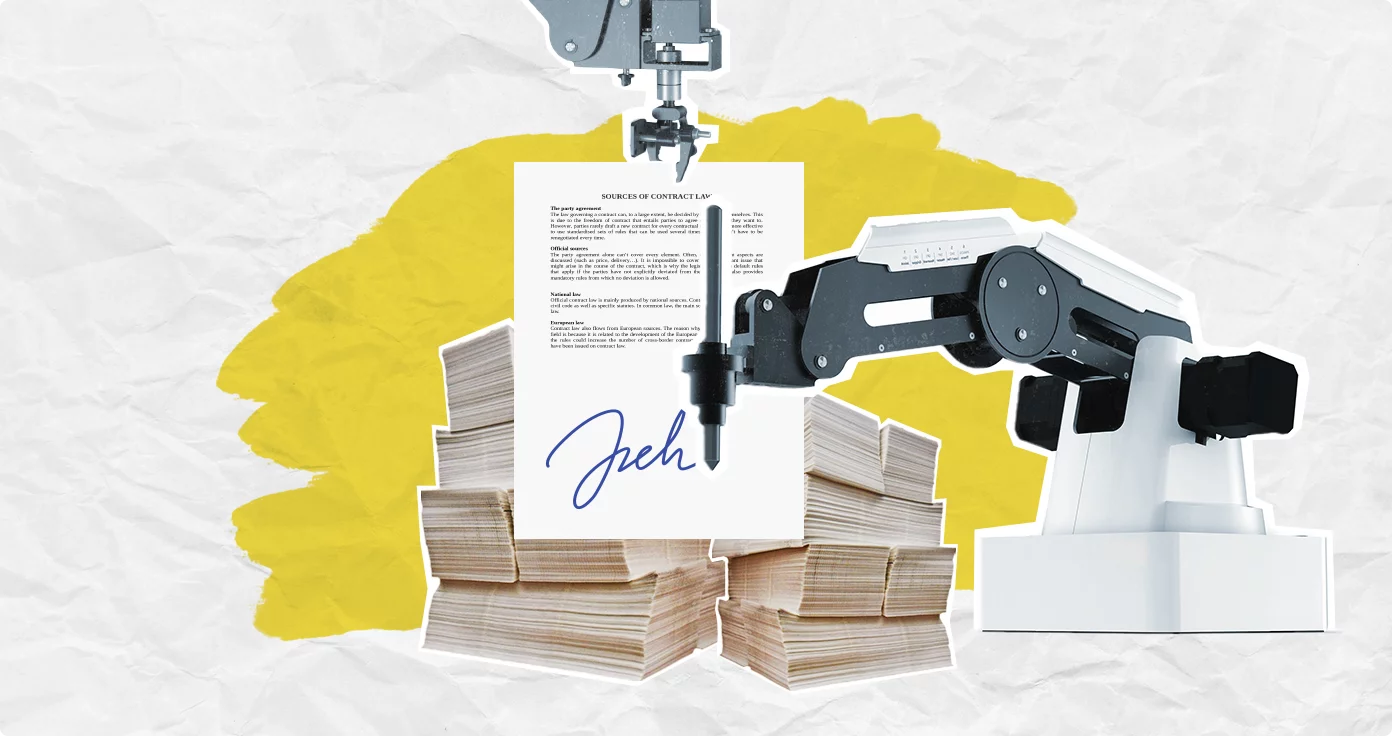
Close deals in the smart way
Choose the best contract management software

Contract management software is one of the most essential parts of your business workflow. The time of advanced technology is upon us, and still, most large enterprises struggle to efficiently manage this essential part of their routine, contract management. On the market today we see poor visibility, decreased compliance and control, high risk of human error, and slow completion cycles.
So what’s wrong with the current process? And how do you finally get to the next level of contract management? This is where the right tool for streamlining your operations comes into play. And that’s exactly what we are going to cover in this article. So hold on tight and get ready to learn about how to start closing deals and managing processes the smart way.
Let’s start with the basics.
Contract management is the process of managing contract creation, execution, and analysis. It aims to maximize the operational and financial performance in an organization while reducing financial risk. Even though the aim is to save money and reduce risk, the process proves to be a very time and cost-consuming element for a business.
When a contract is phrased or processed poorly, an organization can lose thousands of dollars just because of a simple mistake it missed. Or because the negotiation process took too long. You don’t have many chances to produce a poorly organized contract or cause delays in business today. Whether we like it or not, in our cruel world of business, we all have to be quick and mobile. Or we’ll leave the arena tomorrow.
The International Association for Contract and Commercial Management (IACCM) calculated that poor contract management practices are costing businesses an average of 9% on revenues each year.
The tradition of managing contracts manually through folder and file cabinet storage is sinking into oblivion. And most businesses prefer to rely on contract compliance software or platforms that streamline administrative tasks and create a centralized, uniform record for each contract and its process.
Administrative costs associated with contracts are reduced by 25%-30% through implementing automation, according to Aberdeen Research.
However, just because you integrated automation doesn’t mean you eliminate all of the bottlenecks. Businesses that purchase sophisticated tools to automate and manage contract lifecycles, still often fail to use the software effectively.
The point is that automation is a trend. And like with other patterns, we can see a lack of understanding of how it works. Because actually, it works differently for different businesses and for different areas in a business you want to automate.
Another problem is that 74% of legal departments consider vendor name and reputation as necessary when assessing new technology. Still, only a few of them think whether they would or could use at least half of the features the software provides them with.
To choose the right software, you should first depict the stages of the contract management process. This way, you’ll see all of the pain points you can then solve with automation.
The process of contract management establishes legal responsibilities between parties, sets prices, and defines conditions for further cooperation. Watch the video below to learn how airSlate can help you streamline contract management for your business:
Let’s go over and name the stages of contract management because you do need to know the enemy before you can fight him.

These processes are often long and even though they’re just a few points here in this article, in real life this lifecycle can take up to weeks, months, and sometimes years depending on the project’s size. However, let’s see how streamlining the stages of contract management can be as simple and relaxing as drinking a morning cup of coffee.
Now that you’ve learned about the typical process of a contract management lifecycle, it’s time to learn about the benefits of automating it.
Paper documents are not safe. You can lose them, they can be stolen, damaged, and easily tampered with. Contracts stored in the cloud are secured by encryption, data loss prevention, secure server locations, and file corruption prevention.
Platforms like airSlate encrypt user communications with the NSA developed SHA-256 encryption algorithm. This algorithm protects data transfers between users, or transfers between user and server, against external access. User documents are stored on Amazon S3 data centers located in the US.
Most of the time contract compliance appeals to rules or guidelines regarding and related to equal opportunity policies and regulations. For example, equal opportunity for employment without regard to age, gender, religion, disability, or national origin.
However, when you decide to use contract management systems you should also pay attention to the platform’s compliance measures. Ensure contract compliance by archiving and locating all of your contracts in a single, secure place. Analyze contracts with AI-powered widgets. Protect your contract’s information with HIPAA and GDPR compliant platforms.
With contract management automation, you greatly decrease the risk of mistakes in the contract. Avoid having to re-enter names, email addresses, or numbers. With platforms like airSlate, you can generate contracts automatically by populating fields in a contract template with data from CRM records, SQL databases, or Excel/Google spreadsheets.
By automating contract management you can share a contract with business partners and let them easily redline and annotate your contract. In doing that, you get a chance to collaborate with your partners over large distances in a fraction of the time. Seeing all the changes to drafts and content becomes fast and simple while gaining the ability to record and retrieve data efficiently and accurately. The best part is, you get contracts approved in seconds, not days or weeks. To execute digital contracts all a party has to do is add their e-signature and apply it to the necessary pages.
With automated contract management, you can increase efficiency by collecting all your favorite tools in one place. Easily integrate with Salesforce, MS Dynamics 365, Google Suite, MS Office 365, Airtable, and much more.
With business process automation platforms like airSlate, you can automate repetitive actions with Bots, software robots that perform actions based on pre-set if-this-then-that conditions. Configure automation Bots to set notifications, send reminders, populate documents with CRM data, etc., for the purposes of automating your workflow to the fullest. Integration Bots allow you to integrate your workflow with the cloud services you’re already using and keep everything you need in one place. For instance, you can transfer data from CRMs, SQL databases, spreadsheets, and other sources without any additional hassle.
Choosing the right contract compliance software is never an easy task. Everybody is trying to find a reasonable balance between paying less and spending less time on setup & deployment.
The market for contract management software is reaching a peak in its development these days, with dozens of different solutions available. Analyzing the pros and cons of the market leaders carefully is the key to making the right decision.
So, let’s have a closer look at the list of contract management software that proves to be the best in contract management automation today.

One of the most well-known digital solutions on the market. It boasts a wide range of features, from an image library to eSignature and document analytics.
A powerful and globally known platform offering several smart solutions and supporting multiple languages. Nintex once started out as a process management solution, then turned into a much more complex platform.
To the best of our knowledge, airSlate is the most recent player on the market for contract management automation. The brand has been gradually developing for several years, from being a simple PDF editor, then to an eSignature tool, now to a full-cycle no-code business process automation platform.
Conga is positioned on the market as a “hybrid contract lifecycle management solution,” thanks to its Salesforce-native applications.
SpringCM was acquired by DocuSign back in 2018 to become DocuSign’s CLM (Contract Lifecycle Management). The DocuSign contract management solution has multiple integrations, with Salesforce likely being the most widely used.
The solution is oriented toward sales and marketing processes within creative industries. It features a huge library of animations, pictures, colors, and much more for creating visually appealing presentations.
The company is proudly serving over 9500 companies worldwide. The solution primarily shapes the initial proposal and tracks it throughout the contract’s lifecycle.
And the reality is that this overview could be extended as the list of contract management software is growing every day. When choosing a solution that would be a perfect fit for your business, we recommend paying attention to the following three key points:
If you’re still at the early stage of searching for the perfect contract management software for your office, let’s figure out how it should actually work.

Close deals in the smart way
Choose the best contract management software
An automated contract management cycle should cover the entire process from creation to execution.
Below is an example of an automated contract management workflow.
Every step is quick and simple. And there’s no chance you’ll miss any changes. While processing contracts with business automation platforms you can focus on primary issues and not waste hours and days on organizational, repetitive tasks.
Contract management software helps eliminate errors, negotiate contracts in real-time, increase contract visibility and the level of security. Basically, it saves you time, money and helps you reach your business goals much faster.
Contracts are the heart of business relationships and revenue in a company. That’s why it’s critically important to give them as much attention and innovation as every other aspect of a business. Today automation is playing a major role in business, and by implementing it to your contract management processes you’ll make the leap towards better and more systematic business development.
Dive deeper into contract negotiation automation by checking out the airSlate Academy’s course on contract management. With the help of this course, you will become an expert in creating contracts, customizing them, and configuring automation with no-code Bots. The course is free, and once you successfully pass the exam at the end, you’ll receive a verified airSlate certificate. Enjoy developing new skills and implementing them into your business
We hope this article will help you select the best software for contract management automation for your business.